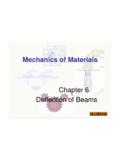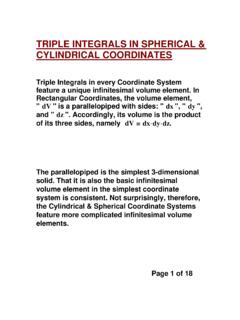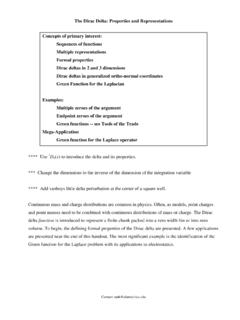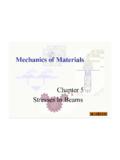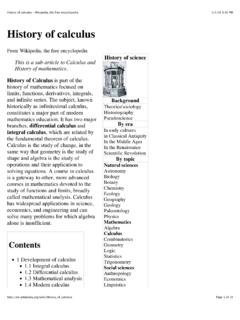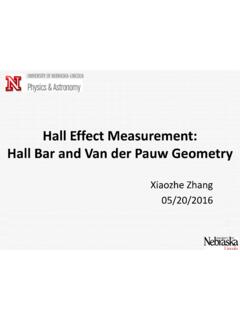Transcription of THE DIFFERENTIAL EQUATIONS OF FLOW
1 42 CHAPTER 5 THE DIFFERENTIAL EQUATIONS OF FLOW In Chapter 4, we used the Newton law of conservation of energy and the definition of viscosity to determine the velocity distribution in steady-state, uni-directional flow through a conduit. In this chapter, we shall examine the application of the same laws in the general case of three-dimensional, unsteady state flow. We will do so by developing and solving the DIFFERENTIAL EQUATIONS of flow. These EQUATIONS are very useful when detailed information on a flow system is required, such as the velocity, temperature and concentration profiles. The DIFFERENTIAL EQUATIONS of flow are derived by considering a DIFFERENTIAL volume element of fluid and describing mathematically a) the conservation of mass of fluid entering and leaving the control volume; the resulting mass balance is called the equation of continuity.
2 B) the conservation of momentum entering and leaving the control volume; this energy balance is called the equation of motion. In describing the momentum of a fluid, we should note that in the case of a solid body, its mass is readily defined and has the dimension, M; the same is true for its momentum which has the dimensions of M L t-1. However, in the case of a fluid, we are dealing with a continuum and the only way to define mass at any given location is in terms of mass flux, mass transport rate per unit cross sectional area through which flow occurs. This quantity is equal to the product of density of the fluid times its velocity ( u) 43and has the dimensions of M t-1 L-2. For the same reasons, the momentum of a fluid is expressed in terms of momentum flux ( u u), transport rate of momentum per unit cross sectional area (M t-2 L-1).
3 In three-dimensional flow, the mass flux has three components (x,y,z) and the velocity also three (ux, uy, and uz); therefore, in order to express momentum, we need to consider a total of nine terms. THE EQUATION OF CONTINUITY Let us consider an infinitesimal cubical element (Fig. ) in the three-dimensional flow of a fluid in a vessel. The mass conservation of fluid passing through this element is stated as follows: rate of mass accumulation within element = = transport rate of mass in - transport rate of mass out ( ) The transport rate of mass into the element at location x and through the face of the element is equal to mass flux of fluid in x-direction surface area of face , Similarly, the transport rate of mass out of the element at location x+dx and through the face is expressed by The only way that mass can be accumulated (or depleted) within the control volume is by a corresponding change in the fluid density.
4 Mathematically, the rate of accumulation is expressed as follows: By substituting from ( )-( ) in the conservation equation ( ) and eliminating redundant terms, we obtain ()( ) dz)(dy uxx ()()( ) dz)(dy dxxu+u dz)(dy uxxxxdx+x ( ) dz)dy (dxt 44 In the above derivation, we used partial differentials because we dealt only with the x-component of velocity. Of course, the same considerations apply to the y- and z-components. Therefore, the general equation of continuity in three-dimensional flow is expressed as follows: or in abbreviated vector notation where u is the velocity vector and . u is called the divergence of the quantity u. By differentiating the product terms on the right hand side of ( ) and then collecting all derivatives of density on the left hand side, we obtain: The left side of ( ) is called the substantial time derivative of density.
5 In a physical sense, the substantial time derivative of a quantity designates its time derivative ( rate of change) evaluated along a path that follows the motion of the fluid (streamline, Chapter 6). In general terms, the substantial time derivative of a variable w is defined by the following expression: Therefore, ( ) can be expressed in abbreviated vector notation as follows: ( ) xu-=tx ( ) zu+yu+xu-=tzyx ( ) u .-=t ( ) zu+yu+xu-=zu+yu+xu+tzyxzyx ( ) zwu+ywu+xwu+tw=DtD(w)zyx 45 EQUATIONS ( ) and ( ) describe the rate of change of density as observed by someone who is moving along with the fluid. For steady state conditions, there is no mass accumulation and the equation of continuity becomes and for an incompressible fluid ( for negligible variation in density of fluid) THE EQUATION OF MOTION To develop the equation of motion, we start from the Newton law of conservation of energy: rate of momentum accumulation = = transport rate of momentum in - transport rate of momentum out + + sum of forces acting on element ( ) In order to express this equation mathematically, we must consider that momentum is transported in and out of the element in two ways.
6 A) convective transport of momentum is by means of the kinetic energy of the fluid mass moving in and out of the six faces of our cubical element. Thus, the convective transport of momentum in the x-direction (x-momentum) consists of three terms: ( ) ( ) 0=zu+yu+xuzyx ( ) 0=zu+yu+xuzyx u)u( ,u)u( ,u)u(xzxyxx 46 The net convective transport of x-momentum through the faces of the cubical element (Fig. ) is Similarly, the net convective transport of x-momentum through the faces and of the element is represented by the terms Of course, there are six more symmetrical terms for convective transport of momentum in the y and z directions of flow.
7 B) diffusive transport of momentum also takes place at the six surfaces of the cubical element (Fig. ) by means of the viscous shear stresses. Thus, the net diffusive transport of momentum in the x-direction through the faces of the element is Similarly, the net diffusive transport of momentum in the x-direction through the faces and is expressed by the terms There are six more symmetrical terms for diffusive transport of momentum in the y and z directions of flow. Let us now consider the forces acting on the control volume of Fig. ()()[]( ) dz)dy (dxxuu-=dz)(dy uu-uuxxdx+xxxx ( ) dz)dy (dxzuu- ( ) dz)dy (dxyuu-xzxy ()()[]( ) dz)dy (dxx-=dz)(dy -xx,xx,dx+xxx,x ( ) dz)dy (dxz- ( ) dz)dy (dxy-xz,xy, The net pressure force acting on the faces of the element ( the faces normal to the x-direction) is There are two more symmetrical terms for the pressure on the faces and of the element.
8 The other force acting on the element is gravity; this is a body force and is equal to the density of the fluid times the volume of the element ( its mass) times the gravitational acceleration. In the x-direction, the gravity force is expressed as follows: where gx is the component of the gravitational acceleration in the direction x. There are two more symmetrical terms for the gy and the gz components of gravity. In developing the equation of continuity (see ( )), we showed that the rate of accumulation of mass in the control element was equal to the time DIFFERENTIAL of density times the volume of the element. Similarly, the rate of accumulation of momentum in the x-direction is expressed by There are two more symmetrical terms for the y and z directions of momentum.
9 We now have mathematical expressions for all the terms of ( ). By substitution and elimination of redundant terms, we obtain the following equation for the equation of motion in the x-direction of momentum: ()( ) dz)dy (dxxP-=dz)(dy P-Pdx+xx ()( ) dz)dy (dxgx ( ) dz)dy (dxtux 48in the y-direction of momentum: and in the z-direction of momentum: The above EQUATIONS of motion can be expressed more conveniently in vector notation as where the bold type indicates vector quantities. It should be noted that if, in addition to gravity, there were other "body" forces acting on the fluid ( an electromagnetic force), their effect would be added to the gravitational components. The vectorial shear stress in ( ) represents six shear stresses ( acting in the direction of flow) and three normal stresses ( ( ) g+xP-z+y+x-zuu+yuu+xuu-=tuxz,xy,xx,xzxyx xx ( ) g+yP-z+y+x-zuu+yuu+xuu-=tuyz,yy,yx,yzyyy xy ( ) g+ 49compressive or tensile stresses normal to the direction of flow).
10 Mathematically, these stresses are expressed as follows (3): Shear stresses: Normal stresses: For incompressible flow ( when changes in density are negligible), we can differentiate each component of convective momentum in the equation of motion (( )-( )) as follows: By eliminating the following terms (see ( )) and moving the remaining convective momentum terms to the left hand side of ( )-( ), we obtain the following simplified equation for the x-momentum balance xu-== ,yu+zu-==,xu+yu-==zx,xz,zyyz,zy,yxxy,yx, _ ( ) .u32-zu2-=_,.u32-yu2-=_,uzzz,yyy, .32-xu2-=xxx, ( ) xuu+xuu=xuuxyyxyx 0=zu+yu+xuuzyxy 50 The left hand side of ( ) will be recognized by the reader as the substantial time derivative of velocity, as defined earlier (see ( )).










